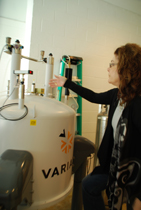Students excited for molecular analyzer, attached printer
November 12, 2007
Washburn University’s Department of Chemistry’s recent purchase of an indispensable research tool left some feeling as though it was Christmas morning.
In October two engineers from scientific instrument supplier Varian spent several weeks installing a Nuclear Magnetic Resonance Spectrometer and giving instructions on its usage. The NMR, as it is called, replaces Washburn’s previous NMR, which dates from 1982.
Put simply, the NMR uses a magnetic field to align the nuclei of certain atoms, usually hydrogen and carbon-13, into two strata and then applies a known amount of energy in the form of radio waves and records how each specific frequency impacts the layers. Using this information, the machine computes the molecular make-up of substances and displays this information. The new NMR has a range of up to 400MHz whereas the old NMR had a range of up to 200MHz. It also has a functioning color printer, a relief to students such as Elisabeth Farnham, who remembers hand drawing spectrums after the printer gave out.
“I’m excited that we got a new one,” said Farnham.
The NMR is an extremely useful tool for advanced chemistry courses. Courses that use the NMR include Advanced Inorganic Chemistry, Instrumental Analysis and Organic Chemistry and II. Farnham says that her biochemistry lab plans to use the new NMR “as soon as it’s ready.”
Almost every professor uses the NMR for research as it is used after almost every reaction to make sure that the reaction occurred correctly. While other instruments, such as the Infrared Spectrometer, can give information on a substance, they all serve slightly different purposes.
“It’s like a boat and a car,” said associate professor Sam Leung, who uses an NMR frequently. “Both transport people and things, but you don’t take a boat on land just like you don’t take a car to sea. Each one has a different purpose.”
Although the $350,000 price tag is not a small consideration, associate professor Shaun Schmidt considers it a great investment.
“Our previous, vintage 1982, 200 MHz NMR was capable of simple structure determinations,” said Schmidt. “With the advances in computer and magnet design, our new 400 MHz NMR provides our students with the opportunity to learn the underlying science and become proficient on a number of additional analytical techniques which will better prepare them for future careers.”



